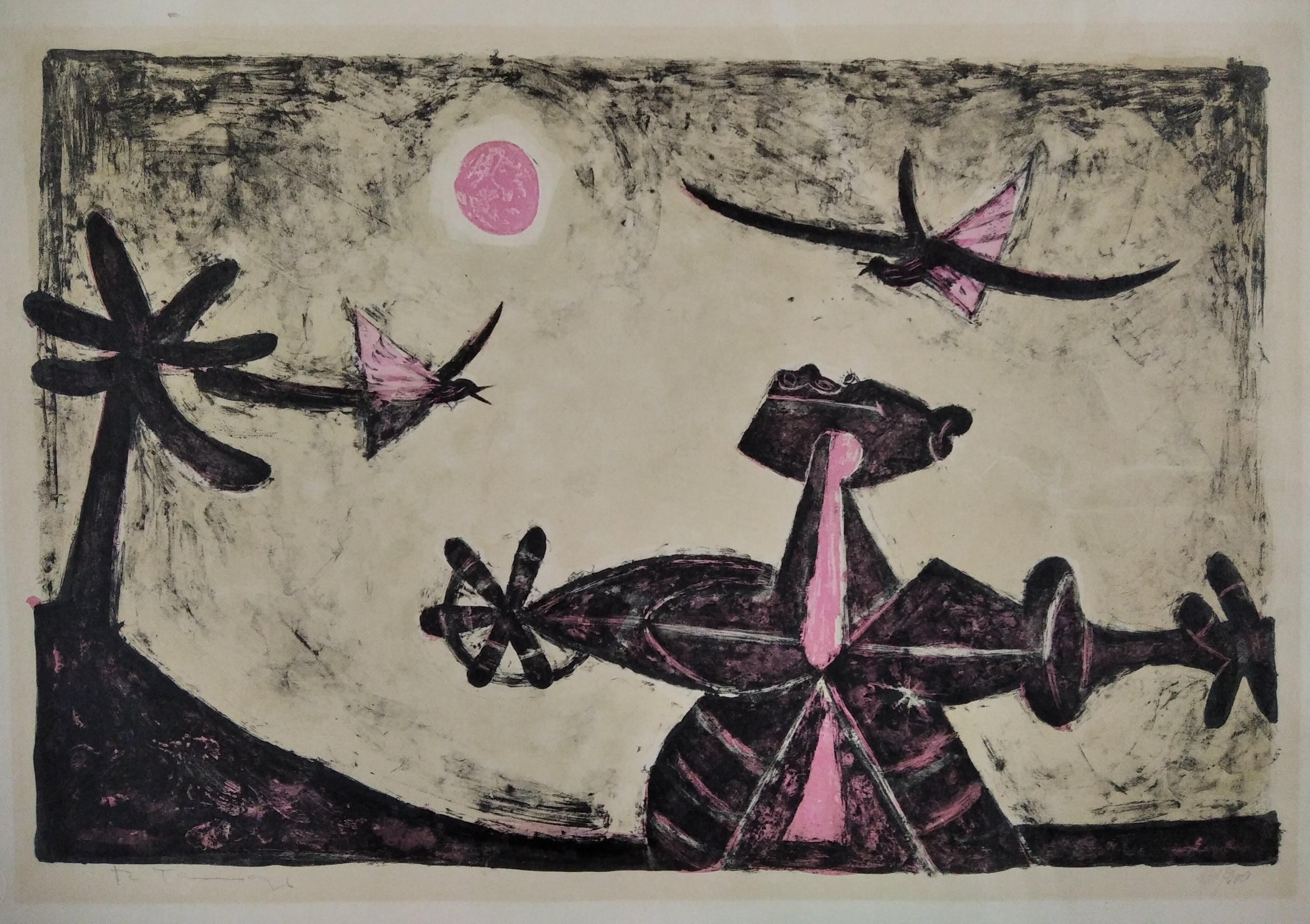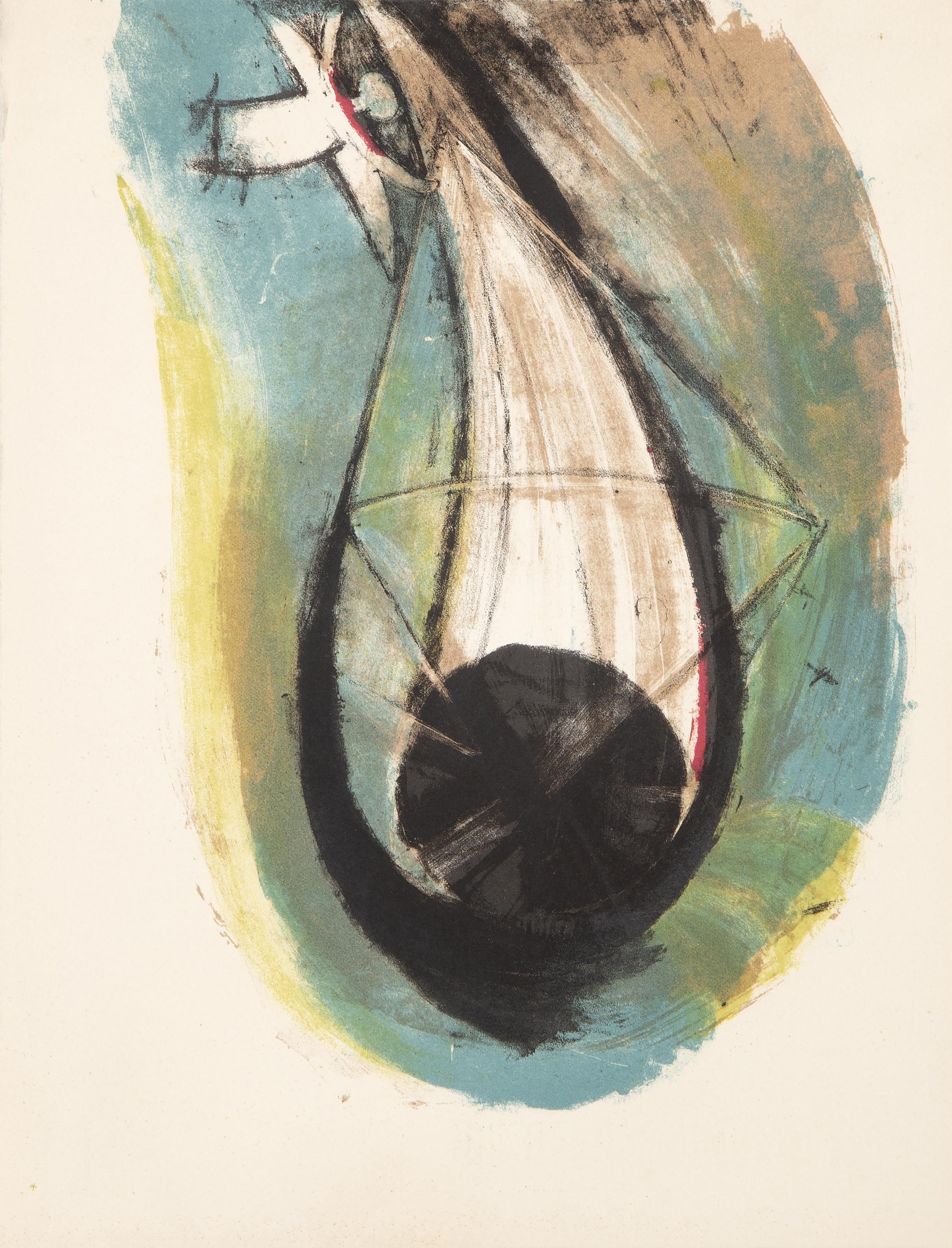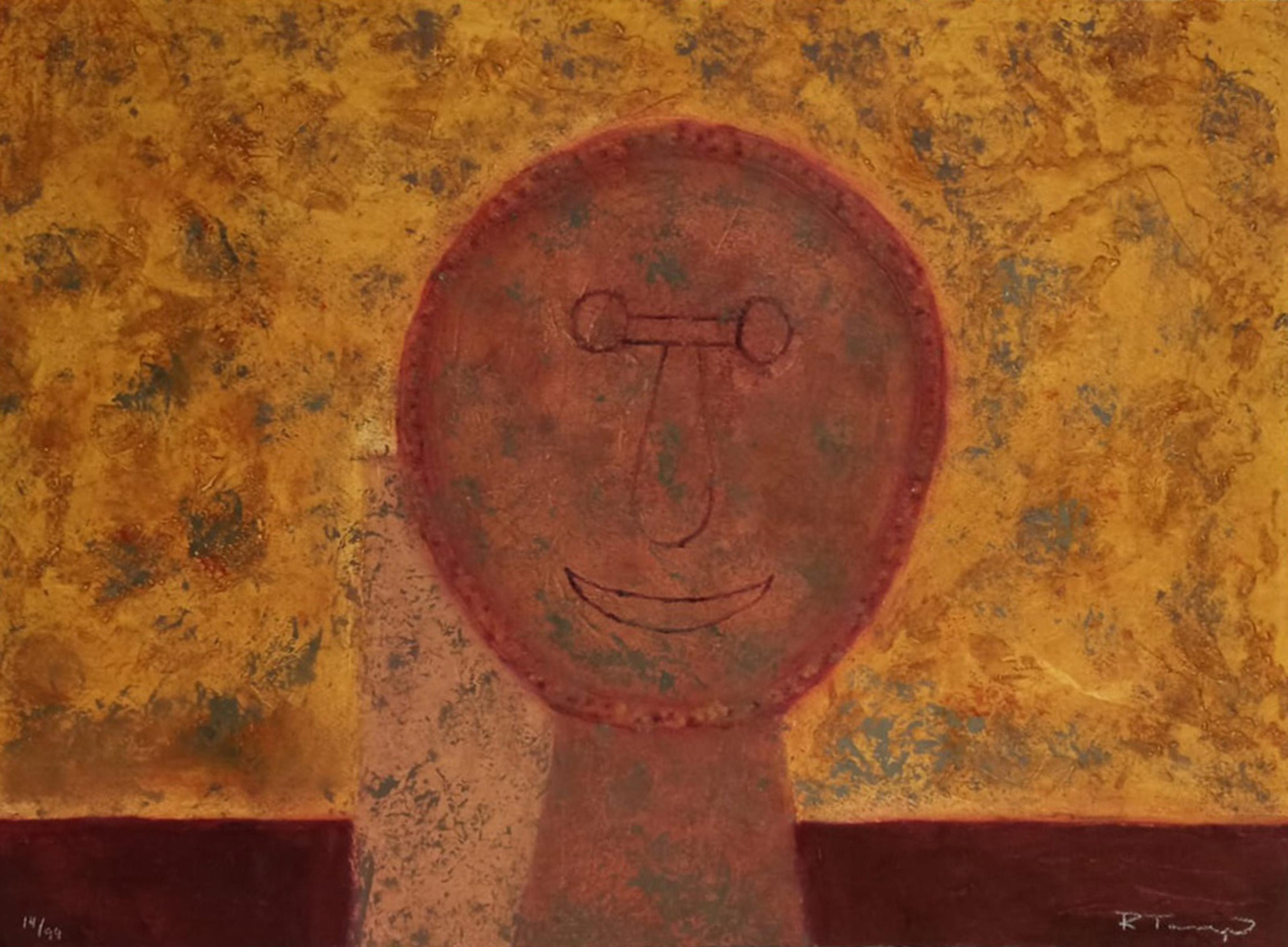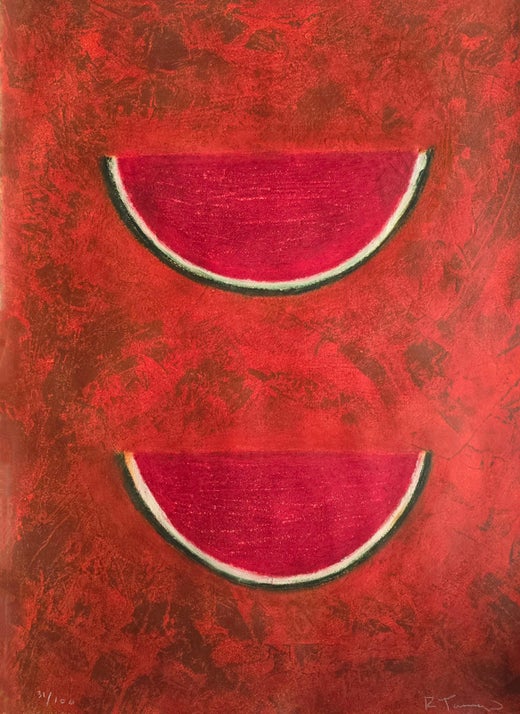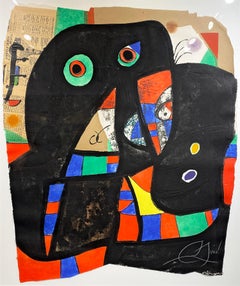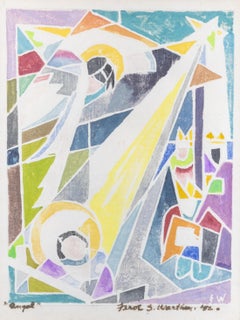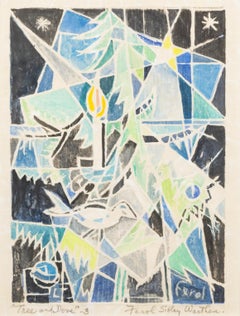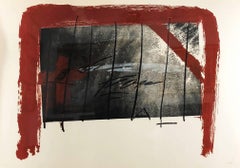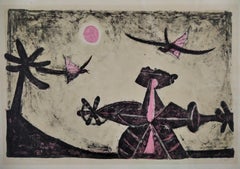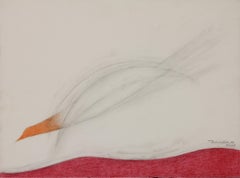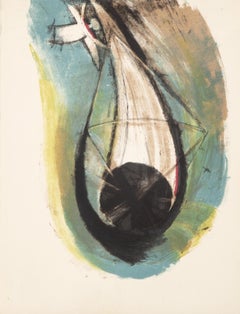Items Similar to Observador de Pajaros
Want more images or videos?
Request additional images or videos from the seller
1 of 8
Rufino TamayoObservador de Pajaros1950
1950
Price Upon Request
Price Upon Request
Price Upon Request
Price Upon Request
Price Upon Request
Price Upon Request
Price Upon Request
Price Upon Request
Price Upon Request
Price Upon Request
About the Item
"Observador de Pajaros" 1950
By. Rufino Tamayo (Mexican, 1899-1991)
Edition 83/200 Lower Right
Signed Lower Left
Unframed: 15.5" x 22.5"
Framed: 21.75" x 28.25"
Rufino Tamayo (August 26, 1899- June 24, 1991)
A native of Oaxaca in Southern Mexico, Rufino Tamayo's father was a shoemaker, and his mother a seamstress. Some accounts state that he was descended from Zapotec Indians, but he was actually 'mestizo' - of mixed indigenous/European ancestry. (Santa Barbara Museum of Art). He began painting at age 11. Orphaned at the age of 12, Tamayo moved to Mexico City, where he was raised by his maternal aunt who owned a wholesale fruit business.
In 1917, he entered the San Carlos Academy of Fine Arts, but left soon after to pursue independent study. Four years later, Tamayo was appointed the head designer of the department of ethnographic drawings at the National Museum of Archaeology in Mexico City. There he was surrounded by pre-Colombian objects, an aesthetic inspiration that would play a pivotal role in his life. In his own work, Tamayo integrated the forms and tones of pre-Columbian ceramics into his early still lives and portraits of Mexican men and women.
In the early 1920s he also taught art classes in Mexico City's public schools. Despite his involvement in Mexican history, he did not subscribe to the idea of art as nationalistic propaganda. Modern Mexican art at that time was dominated by 'The Three Great Ones' : Diego Rivera, Jose Clemente Orozco, and David Alfaro Siqueros, but Tamayo began to be noted as someone 'new' and different' for his blending of the aesthetics of post Revolutionary Mexico with the vanguard artists of Europe and the United States.
After the Mexican Revolution, he focused on creating his own identity in his work, expressing what he thought was the traditional Mexico, and refusing to follow the political trends of his contemporary artists. This caused some to see him as a 'traitor' to the political cause, and he felt it difficult to freely express himself in his art. As a result, he decided to leave Mexico in 1926 and move to New York, along with his friend, the composer Carlos Chavez. The first exhibition of Tamayo's work in the United States was held at the Weyhe Gallery, New York, in that same year. The show was successful, and Tamayo was praised for his 'authentic' status as a Mexican of 'indigenous heritage', and for his internationally appealing Modernist aesthetic. (Santa Barbara Museum of Art).
Throughout the late thirties and early forties New York's Valentine Gallery gave him shows. For nine years, beginning in 1938, he taught at the Dalton School in New York.
In 1929, some health problems led him to return to Mexico for treatment. While there he took a series of teaching jobs. During this period he became romantically involved with the artist Maria Izquierdo, with whom he lived and worked for several years. In 1933 he completed his first successful mural commission, a series of wall paintings for the Escuela Nacional de Musica (National School of Music). While working on this project, he met Olga Flores Rivas, a piano student at the school. Soon he separated from Izquierdo, and began a romance with Olga. The two were married in 1934. Although Olga was talented and had a budding performance career, she abandoned her musical pursuits to devote herself to promoting Tamayo's work. She was a lifelong muse to the artist, and over his seventy year career, he drew and painted many portraits of her.
They moved to New York in 1937, and he began to exhibit his work internationally. From 1937 to 1949, Tamayo and Olga lived there, and he became widely recognized for his signature form of abstract figuration. Some of his most valuable works were created during that time.
In 1943 Tamayo painted his first mural in the United States at the Hillyer Art Library at Smith College. Vogue magazine's 1946 issue referred to him as 'the best of young painters'. Look magazine also named him 'a fixed star in the New York art world'. (Santa Barbara Museum of Art) He was an elegant and media-savvy man, often photographed in his Upper East Side studio, with its wall of windows facing out onto Manhattan's fashionable townhouses.
The 1940s were however not without problems for the couple. Olga suffered from health problems, leading to several miscarriages, and the marriage was strained. Tamayo dedicated his work to her by adding an extra 'O' to his signature.
His fame was growing in Mexico. In 1948 his first major retrospective was held at the Palacio de Bellas Artes in Mexico City, and while he was still controversial, his popularity was high. He enjoyed broad commercial and critical success, but remained uncomfortable with the political differences and controversy, and so Tamayo and Olga moved to Paris in 1949. There he was welcomed by the artists and intellectuals of Europe. The French government named him Chevalier and Officier de la Légion d'Honneur in 1956 and 1969, respectively, and he was the recipient of numerous other honors and awards. Tamayo was among the first Mexican artists to be included in the Venice Biennale. He remained in Paris for 10 years, after which the couple returned permanently to Mexico.
His work was exhibited internationally in group and solo shows. Important Tamayo retrospectives took place at the São Paulo Bienal in 1977 and the Solomon R. Guggenheim Museum, New York, in 1979.
From 1933 to 1980, Tamayo painted 21 murals for an array of universities, libraries, museums, civic and corporate clients, hotels and an ocean liner. He was also an influential printmaker, and, in the latter part of his life embarked on the creation of sculpture. Tamayo eschewed the highly politicized themes explored within the works of his peers, and favored lyrical imagery and incorporated elements of Cubism, Surrealism and Expressionism. Mexican folklore and his Indian origins provided a constant source of inspiration for him.
Through his 70s and 80s he continued to be a prolific artist, teacher, and collector. Critics have extolled his bold and saturated use of color as his most significant contribution to Modern art. He was elected an honorary member of the American Academy and National Institute of Arts and Letters in 1961.
Rufino and Olga Tamayo donated the Museum of Pre-Hispanic Mexican Art to their native State of Oaxaca in 1974. Their personal holdings of more than 1,000 pieces of ceramics and sculpture formed the cornerstone of the collection. The Rufino Tamayo Museum of International Contemporary Art opened in Mexico in 1981, and it displays many of the artist's works, as well as paintings, sculpture and drawings from his private collection. At the time, it was the first major museum not run by the Government.
An interesting sidelight regarding Tamayo's work has to do with a theft. Tamayo's 1970 painting 'Tres Personajes' was bought by a Texan as a gift for his wife in 1977, then stolen from their storage locker during a move in 1987. In 2003, a woman, Elizabeth Gibson, found the painting in the trash on a New York City curb. She knew little about modern art, but felt the painting "had power" and took it without knowing its origin or market value. She spent four years trying to learn about the work, eventually learning it had been featured on an episode of Antiques Roadshow. Ultimately, Gibson and the former owner arranged to sell the painting at a Sotheby's auction. In November, 2007 Gibson received a $15,000 reward plus a portion of the $1,049,000 auction sales price.
Tamayo painted his last painting in 1989, at the age of 90, 'Hombre Con Flor' (Man withFlower), a self-portrait. Rufino Tamayo died in 1991 at the age of 92 in Mexico City. Olga passed away two and a half years later.
- Creator:Rufino Tamayo (1899-1991, Mexican)
- Creation Year:1950
- Dimensions:Height: 15.5 in (39.37 cm)Width: 22.5 in (57.15 cm)
- Medium:
- Movement & Style:
- Period:
- Condition:
- Gallery Location:Missouri, MO
- Reference Number:1stDibs: LU747310679552
Rufino Tamayo
Rufino Tamayo was born in Oaxaca, Mexico, in 1899 to parents Manuel Arellanes and Florentina Tamayo. Tamayo was active in the mid-20th century in Mexico and New York, painting figurative abstraction with surrealist influences. Although Tamayo studied drawing at the Academy of Art at San Carlos as a young adult, he became dissatisfied and eventually decided to study on his own.
About the Seller
5.0
Vetted Professional Seller
Every seller passes strict standards for authenticity and reliability
Established in 1970
1stDibs seller since 2017
156 sales on 1stDibs
Typical response time: Several days
- ShippingRetrieving quote...Shipping from: Missouri, MO
- Return Policy
More From This Seller
View AllGaudi XX, (D. 1079)
By Joan Miró
Located in Missouri, MO
Gaudi XX, (D. 1079), 1979
By. Joan Miro
Signed Lower Right
Edition 41/50 Lower Left
Unframed: 37.5" x 30.75"
Framed: 46.5" x 39"
Joan Miro was born in Barcelona, Spain on April 20, 1893, the son of a watchmaker. From 1912 he studied at the Barcelona Ecole des Beaux-Arts and the Academie Gali. In the first quarter of the 20th century, Barcelona was a cosmopolitan, intellectual city with a craving for the new in...
Category
20th Century Abstract Abstract Prints
Materials
Paper, Etching, Aquatint
Price Upon Request
Angel
Located in Missouri, MO
Angel, 1952
Ferol K. Sibley Warthen (American, 1890-1986)
Color Woodblock Print
6.5 x 5 inches
16 x 13.75 inches with frame
Signed Lower Right
Titled Lower Left
Born 1890, Died 1986...
Category
1950s American Modern Abstract Prints
Materials
Color
Tree and Dove
Located in Missouri, MO
Tree and Dove
Ferol K. Sibley Warthen (American, 1890-1986)
Color Woodblock Print
Edition of 3
6.25 x 4.75 inches
13 x 11.5 inches with frame
Signed Lower Right
Titled Lower Left
Born 1890, Died 1986...
Category
Mid-20th Century American Modern Animal Prints
Materials
Color
Lit Rouge
By Antoni Tàpies
Located in Missouri, MO
Color Lithograph
Pencil Signed and Numbered 48/50
Image Size: approx 22 x 29 inches
Framed Size: approx 30.25 x 41 inches
Antoni Tàpies was born December 13, 1923, in Barcelona and ...
Category
1970s Modern Abstract Prints
Materials
Lithograph
$3,600 Sale Price
20% Off
Diurnes (Femme Assise En Pyjama De Plage II)
By Pablo Picasso
Located in Missouri, MO
Pablo Picasso
"Diurnes" (Femme Assise En Pyjama De Plage II) 1962
Linocut printed in ochre and brown, 1962, on Arches paper
Inscribed "Epreuve D'Artist" (Artist Proof) lower left, as...
Category
1960s Modern Abstract Prints
Materials
Linocut
Price Upon Request
Pensees Germinales
By Mark Tobey
Located in Missouri, MO
Mark Tobey
"Pensees Germinales" 1973
Drypoint Engraving Printed in Brown and Blue by Willie Steinert, Karlsruhe, Germany, on Auvernge Paper Handmade by Richard de Bas
Signed Lower R...
Category
1970s Abstract Abstract Prints
Materials
Engraving, Drypoint
Price Upon Request
You May Also Like
Untitled
By Rufino Tamayo
Located in Barcelona, BARCELONA
The painting is being offered with a work and authenticity certificate
Category
1990s Abstract Expressionist More Prints
Materials
Lithograph
Cabeza con Pajaros
By Rufino Tamayo
Located in San Francisco, CA
This artwork titled "Cabeza con Pajaros" 1958, is an original colors lithograph on Wove paper by renown Mexican artist Rufino Tamayo, 1899-1991. It is hand signed and numbered 273/30...
Category
Mid-20th Century Modern Figurative Prints
Materials
Lithograph
Flying Bird
By Rufino Tamayo
Located in San Francisco, CA
We're pleased to showcase Mexican Master Rufino Tamayo's work on paper. Flying Bird portrays a bird flying over the mountains. Rufino Tamayo created this modernist and minimalist dra...
Category
1960s Minimalist Animal Drawings and Watercolors
Materials
Paper, Crayon, Graphite
$18,000 Sale Price
20% Off
Capitulo XXI, Surrealist Lithograph by Rufino Tamayo
By Rufino Tamayo
Located in Long Island City, NY
Rufino Tamayo, Mexican (1899 - 1991) - Capitulo XXI, Portfolio: Apocalypse de Saint Jean, Year: 1959, Medium: Lithograph on BFK Rives, Edition: 93/255, Size: 13 x 10 in. (33.02 x 25....
Category
1960s Surrealist Abstract Prints
Materials
Lithograph
Nino Con Pajaros (Variant)
By Rufino Tamayo
Located in San Francisco, CA
This artwork titled "Nino Con Pajaros" Variant, 1976, is a color etching on Guarro paper by renown Mexican artist Rufino Tamayo, 1899-1991. It is hand signed and numbered 40/75 in black crayon by the artist. Published by Ediciones Poligrafa, Barcelona, Spain. The artwork (sheet) size is 29.5 x 22 inches, framed size is 41.25 x 33.75 inches. Referenced and pictured in the artist's catalogue raisonne by Pereda, plate #199 page 169. Custom framed in a wooden black frame, with light beige fabric matting. It is in excellent condition.
About the artist:
A native of Oaxaca in Southern Mexico, Rufino Tamayo's father was a shoemaker, and his mother a seamstress. Some accounts state that he was descended from Zapotec Indians, but he was actually 'mestizo' - of mixed indigenous/European ancestry. (Santa Barbara Museum of Art). He began painting at age 11. Orphaned at the age of 12, Tamayo moved to Mexico City, where he was raised by his maternal aunt who owned a wholesale fruit business.
In 1917, he entered the San Carlos Academy of Fine Arts, but left soon after to pursue independent study. Four years later, Tamayo was appointed the head designer of the department of ethnographic drawings at the National Museum of Archaeology in Mexico City. There he was surrounded by pre-Colombian objects, an aesthetic inspiration that would play a pivotal role in his life. In his own work, Tamayo integrated the forms and tones of pre-Columbian ceramics...
Category
Mid-20th Century Modern Figurative Prints
Materials
Etching
Cabeza Sobre Fondo Verde, Surrealist Etching by Rufino Tamayo
By Rufino Tamayo
Located in Long Island City, NY
Rufino Tamayo, Mexican (1899 - 1991) - Cabeza Sobre Fondo Verde, Portfolio: Rufino Tamayo 15 aquafuertes, Year: 1979, Medium: Etching, signed and numbered in crayon, Edition: 14/...
Category
1970s Surrealist Portrait Prints
Materials
Etching
More Ways To Browse
Maria Izquierdo
Robert Motherwell Etching
Roger Brown Prints
The Son Of Man Rene Magritte
Vintage Nagel Prints
Vintage Spray Cans
Calder Wire Sculpture
Damien Hirst Spots
Ezra Pound
Jim Dine Signed Prints
Louis Breton
Miro Orange
Picasso Woodcut
Robert Motherwell Untitled
Robert Rauschenberg Signed
Alfred Manessier Lithograph
Charles Biederman
Jasper Johns Signed
